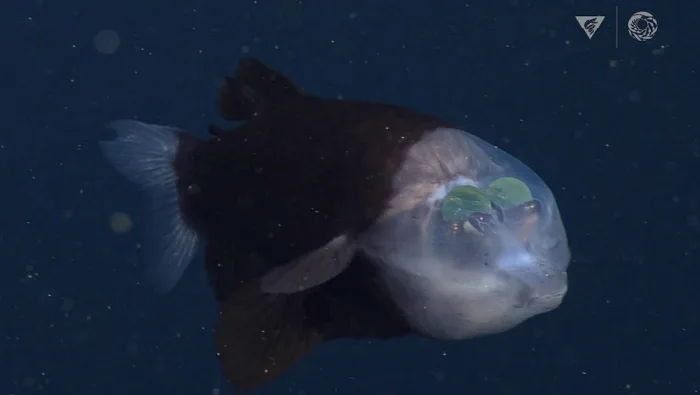
Elusive fish with transparent head caught on camera
The fish is rarely caught on camera, and scientists still have a lot to learn about it.
Hundreds of metres below the surface in Monterey Bay, California, scientists have caught a rare glimpse of a fish with a transparent head and glowing green eyes that are visible through its forehead.
Known as barreleye fish (Macropinna microstoma), these creatures are a rare sight.
Scientists have conducted more than 5,600 dives with their remotely operated vehicles in the area. The barreleye has only been caught on camera nine times, despite filming more than 27,000 hours of footage.
Much of what experts think they know about the elusive barreleye is speculation-based.
"We have no handle on population size, except in a relative sense," Bruce Robison, a Monterey Bay Aquarium Research Institute (MBARI) senior scientist, told Live Science.
Scientists first described the fish in 1939, but the fluid-filled shield is rarely mentioned because when it was brought to the surface from the deep sea, the shield was often destroyed.
In 2008, Robison and his MBARI colleague Kim Reisenbichler brought a live, net-caught barreleye to the surface, which they observed for several hours in an aquarium on their ship.

A barreleye fish (Macropinna microstoma) observed by MBARI’s ROV Ventana during a dive from the R/V Rachel Carson with the Monterey Bay Aquarium on December 1, 2021. © 2021 MBARI
"Like several other species in the family, Macropinna has upward-directed tubular eyes and a tiny, terminal mouth. This arrangement is such that in their upright position, the visual field of these highly specialized eyes does not include the mouth, which makes it difficult to understand how feeding takes place," Robison and Reisenbichler write in a paper describing their findings.
"In situ observations and laboratory studies reveal that the eyes of Macropinna can change position from dorsally-directed to rostrally-directed, which resolves the apparent paradox. The eyes are contained within a transparent shield that covers the top of the head and may provide protection for the eyes from the tentacles of cnidarians, one of the apparent sources of the food of Macropinna."
Barreleyes live in the 'twilight zone' of the ocean at depths of 600 to 800 metres.
Light is scarce - forcing species to develop unusual adaptations. In the case of the barreleye, that translated into light-sensitive eyes that rotate within the shield.
They are thought to be motionless most of the time, waiting around for prey - like jellyfish - to float overhead. Barreleyes can spot them from above thanks to their rotating eyes, and the green pigment may help filter out sunlight from the ocean surface.
The species represents one of the countless creatures lurking in the deep sea.
According to the National Oceanic and Atmospheric Administration, more than eighty percent of our ocean has yet to be explored, due to the high cost and difficulty in navigating the terrain. A 2011 study suggests that up to 91 per cent of ocean species remain undiscovered.
About 2,000 new marine species are added to the registrar each year.










